Categories: Featured Articles » Electrician at home
Number of views: 101303
Comments on the article: 5
Apartment electrical panels - purpose, types, composition and equipment
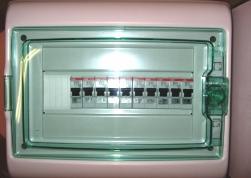 Electricity entering the living room (for example, the apartment) must be distributed. It must be routed to lighting circuits, to outlets, to stationary consumers such as a hob or air conditioner. In addition, it would be nice to take into account and calculate the same energy. Why do we have to pay the average kilowatt-hour set by the energy supplier, paying for all house losses? There is simply no way to do without an electricity meter.
Electricity entering the living room (for example, the apartment) must be distributed. It must be routed to lighting circuits, to outlets, to stationary consumers such as a hob or air conditioner. In addition, it would be nice to take into account and calculate the same energy. Why do we have to pay the average kilowatt-hour set by the energy supplier, paying for all house losses? There is simply no way to do without an electricity meter.
But, of course, this is not enough. After all, electricity can be not only “good”. Overcurrents of short circuits and overload currents do not spare the wiring and can cause a fire. Electric current itself is dangerous for human health and life. Therefore, to "tame" the electricity at the input, it is necessary to install devices of maximum current protection, and protection devices against leakage currents will not be superfluous.
Well, where is all this to be realized? What is this complete device that can accommodate all these devices and numerous wires and cables? Of course it is apartment distribution switchboard.
By the way, not every apartment shield incorporates all of the above. After all, electricity meters are not installed in every apartment. Useful devices such as RCDdifferential circuit breakers and surge arresters.
But overcurrent protection devices are present in almost every apartment electrical panel, with the exception of very ancient and extremely dangerous cases, when all the zero and all phase conductors are twisted in the opening wiring box.
When circuit breakers were still a rarity and impressed with their dimensions, the apartment shields were a metal plate attached to the wall on the bracket-sleeves using ordinary nails. The bushings provided some distance from the combustible wall: a tribute to fire safety. The overcurrent protection devices in such shields were the well-known "traffic jams" - fuses in a carbolite case.
There were usually only two traffic jams on such an antediluvian switchboard: one on the phase conductor, and the second on the zero. It is far from safe to break the neutral conductor with switching devices (and the plug is the switching device), but in those days they did not attach much importance to this. Electric meter, if available, was located on such shields before traffic jams, in order to avoid theft of electricity.
No household terminal blocks Soviet industry did not produce zero tires then, so it seemed convenient to place all the zero and phase wires on the plugs of the plugs. There were no group switching devices at all, lighting circuits and socket circuits were combined. Therefore, if at least one cork burned out, the lights went out in the entire apartment. And since there were not always enough fuses, instead of them, “bugs” or fuses of a higher rating were often installed.
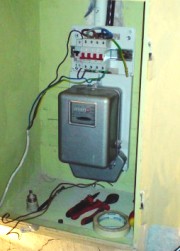 In a word, the safety of the first apartment electrical panels was at the lowest level. It is even more strange that such guards are still in operation in many garages, cottages and even apartments. For the "happy" owners of these shields, a special PAR series circuit breaker is even produced, which is screwed like a cork thanks to the standard E27 base.
In a word, the safety of the first apartment electrical panels was at the lowest level. It is even more strange that such guards are still in operation in many garages, cottages and even apartments. For the "happy" owners of these shields, a special PAR series circuit breaker is even produced, which is screwed like a cork thanks to the standard E27 base.
With the advent of compact circuit breakers, such as the AE series, which are fastened with screws, the situation with apartment electrical panels began to improve.Compared to traffic jams, circuit breakers have undeniable advantages: after tripping, they simply need to be switched on again, eliminating the cause of the accident. This eliminates the possibility of the appearance of "bugs" and the need for a systematic search for new traffic jams instead of burnt old ones.
Circuit breakers began to be mounted on the same metal plates with bushings. But there appeared complete devices that looked like this: at the top in a horizontal position are group circuit breakers (usually room-by-room, without dividing into lighting groups and groups of outlets), below is a classic disk electromechanical electricity meter, and at the very bottom is an introductory package switch PV tearing and zero and phase lead-in conductors.
The electric stove - the only stationary electric receiver at that time - was connected through a separate circuit breaker. Zero working wires were assembled under the clamps on the metal housing of the shield, and a protective zero was provided only for the same plate - a separate line.
But the appearance of such a shield, even by the standards of Soviet life, did not particularly adorn the interior. Of course, unlike the usual shields with plugs, everything was arranged orderly in the new complete devices, and the contacts of the devices were covered with metal covers. But the wires still did not stick out very nicely, especially the zero ones.
Therefore, in multi-apartment buildings built in the eighties and nineties were used apartment electrical panels three to four apartments at once. It is these shields that are well known to Russians living in faceless sleeping areas of large cities.
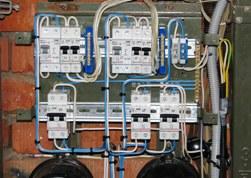 Multi-dashboard mounted at the entrance to the landing and did not upset the residents with their dull appearance. It was a large metal cabinet built into the wall. The space of this cabinet was divided into four parts, each of which had a complete set for metering and distribution of electricity: an introductory PV bag, a counter, group circuit breakers and a zero bus with clamps.
Multi-dashboard mounted at the entrance to the landing and did not upset the residents with their dull appearance. It was a large metal cabinet built into the wall. The space of this cabinet was divided into four parts, each of which had a complete set for metering and distribution of electricity: an introductory PV bag, a counter, group circuit breakers and a zero bus with clamps.
The case of such a shield must be connected to the zero main wire (riser). And his door had transparent windows for taking meter readings.
In the dashing nineties, one unexpected flaw of the apartment shields located at the entrance was clearly evident. Their regular lock is too flimsy and is designed only for an honest person. As a result, young people who became victims of drug addiction, as well as other socially disoriented dark personalities, raided Russian entrances and pretty much cleaned up their electrical panels, making profit mainly from electricity meters.
Frightened citizens acted differently: someone refused to set the meter again, paying for the average energy, someone set the meter again, providing the flap door with a master's barn lock, and someone moved the meter to his apartment, holding out the necessary cable.
Today, everything is done for convenience when performing electrical installation. Therefore, ready-made complete switchgears are produced, for example, SCHKU (panel board with a meter for electricity consumption) and ShchKR (switchboard apartment).
These are metal lockers designed for both hidden and open wiring. Working with them, the installer is no longer obliged to delve into the principles of distribution and metering of electricity. Everything is simpler than simple: here you connect the input cable, and group lines enter here. It is simply impossible to get confused.
ShchKU and ShchKR guards are available in various modifications in terms of power and number of groups. In addition, such shields are three-phase and single-phase, and both the one and the other option provides for the possibility of connecting a protective zero core (PE). In a word, I bought a shield ShchKU or ShchKR - and my head does not hurt.
But still, the finished complete apartment shields did not become very popular. There are objective reasons for this: the finished shield does not leave any freedom for "creativity".But the wiring of each living room has some peculiarities.
The number of group circuit breakers, their denomination, the presence of such protection devices as RCDs, differential circuit breakers and surge arresters - all this with great difficulty fits into some templates and ready-made technical solutions.
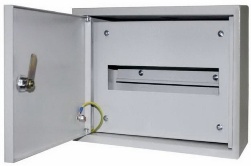 Therefore, today the most popular are "empty" boards like ЩРН or ЩРВlocated in the apartment itself. These guards are modular, inside they contain a DIN rail - universal fasteners for any protection, distribution and metering devices. The owner of the shield has the opportunity to independently purchase the necessary devices with a DIN mount and mount them in the required combination.
Therefore, today the most popular are "empty" boards like ЩРН or ЩРВlocated in the apartment itself. These guards are modular, inside they contain a DIN rail - universal fasteners for any protection, distribution and metering devices. The owner of the shield has the opportunity to independently purchase the necessary devices with a DIN mount and mount them in the required combination.
ShchRN panels are mounted as part of a hidden or open wiring, and ShchRV are framed along the edge with a special collar and are mounted only if the wiring is hidden. Both are available in fireproof, shockproof plastic or metal.
The dimensions of the switchboards are determined by the number of modules that can fit inside the shield. Therefore, when choosing a shield, we determine which devices will be installed in it, and then we consider the modules. The calculation is done in this way: for each pole of the circuit breaker - one module, for single-phase difavtomat - one or two modules, depending on the type, for a single-phase meter - from one to five modules, for a three-phase meter - up to 9 modules. Well, of course, several modules must be left in reserve. Thus, apartment shields for a three-phase network can have up to 36 modules located in several tiers.
With the number of modules from six, the ShchR shields are equipped not only with a working (N), but also with a protective (PE) zero bus. Plastic shields have a transparent door and are comfortable for meter reading.
Summing up, we note that the switchboards have become so popular due to the compactness of modular equipment and the ability to design complete switchgear with optimal parameters. Most electricians give preference to shchR guards.
Alexander Molokov
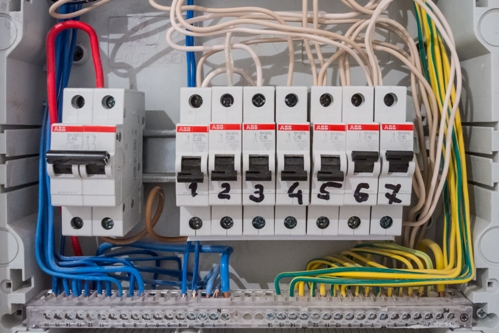
See also at e.imadeself.com
:
